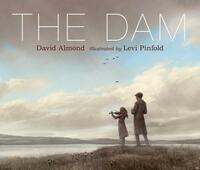Take a photo of a barcode or cover
The illustrations in this book are beautiful. I enjoyed the story more when I read the afterward and realized what the book was actually about. I was hoping to get that clarity from the dialog in the story, but didn't.
“This will be gone...and this will be washed away...and this will never be seen again:” this celebration of a village lost when Kielder reservoir was built is a superb production in terms of language and art work. Haunting, muted tones fill the pictures in the first pages, as a child plays a violin to say goodbye to the family village and its way of life just as the dam is completed. Brighter colours bring us to the glory of open water and peaceful countryside in the present day: this is no longer a place of mourning, although it is only with some wistfulness that the music is played again.
Music unites the times and inspires an understanding of what was lost so that “within the water the music stays...it flows through all the dams in us..”
A really subtle book, rich, celebratory, yet regretful.
Music unites the times and inspires an understanding of what was lost so that “within the water the music stays...it flows through all the dams in us..”
A really subtle book, rich, celebratory, yet regretful.
Based on a true story retold to him by the Tickells, Almond (with Pinfold outstanding illustrations) tells the tale of the building of the largest artificial lake in the UK. Set in Northumberland, it follow the story of a father and daughter who visit the land which is to be lost to the lake. Instead of anger, they choose to sing, dance and play music to the memories of those who have left and the homes that now lay empty.
What is beautiful about this story is that the dam itself also brings a peace and tranquility with it but that the music within the lake and the stories of all those who had lived there should be remembered and celebrated. It is not, as would be so easy to do, cast as the villain but rather as an image of change and new beginnings.
I had read a picturebook written by Almond only a few months ago and it was poor. He wrote too many words and didn't trust the illustrator to handle the telling. Not this time. This time it feels as if Almond understands that the picturebook should be the cradle for words and pictures to work together. He gives Pinfold the space to share his own vision of the bleak yet beautiful Northumberland landscape and in doing so, together they sing and dance a beautiful story: one that I will not forget.
What is beautiful about this story is that the dam itself also brings a peace and tranquility with it but that the music within the lake and the stories of all those who had lived there should be remembered and celebrated. It is not, as would be so easy to do, cast as the villain but rather as an image of change and new beginnings.
I had read a picturebook written by Almond only a few months ago and it was poor. He wrote too many words and didn't trust the illustrator to handle the telling. Not this time. This time it feels as if Almond understands that the picturebook should be the cradle for words and pictures to work together. He gives Pinfold the space to share his own vision of the bleak yet beautiful Northumberland landscape and in doing so, together they sing and dance a beautiful story: one that I will not forget.
emotional
hopeful
reflective
sad
medium-paced
It is a semi-sophisticated picture book with deeper implications about the conflict between societal development and nostalgia for the simple life. The illustrations are muted in colour and beautiful, a visual representation of the theme.
This hauntingly gorgeous picture book tells the story of a final visit to an English village in Kielder Valley before it is forever changed by the building of a dam. It is a tale of loss, hope, and the healing, beautiful power of music.





